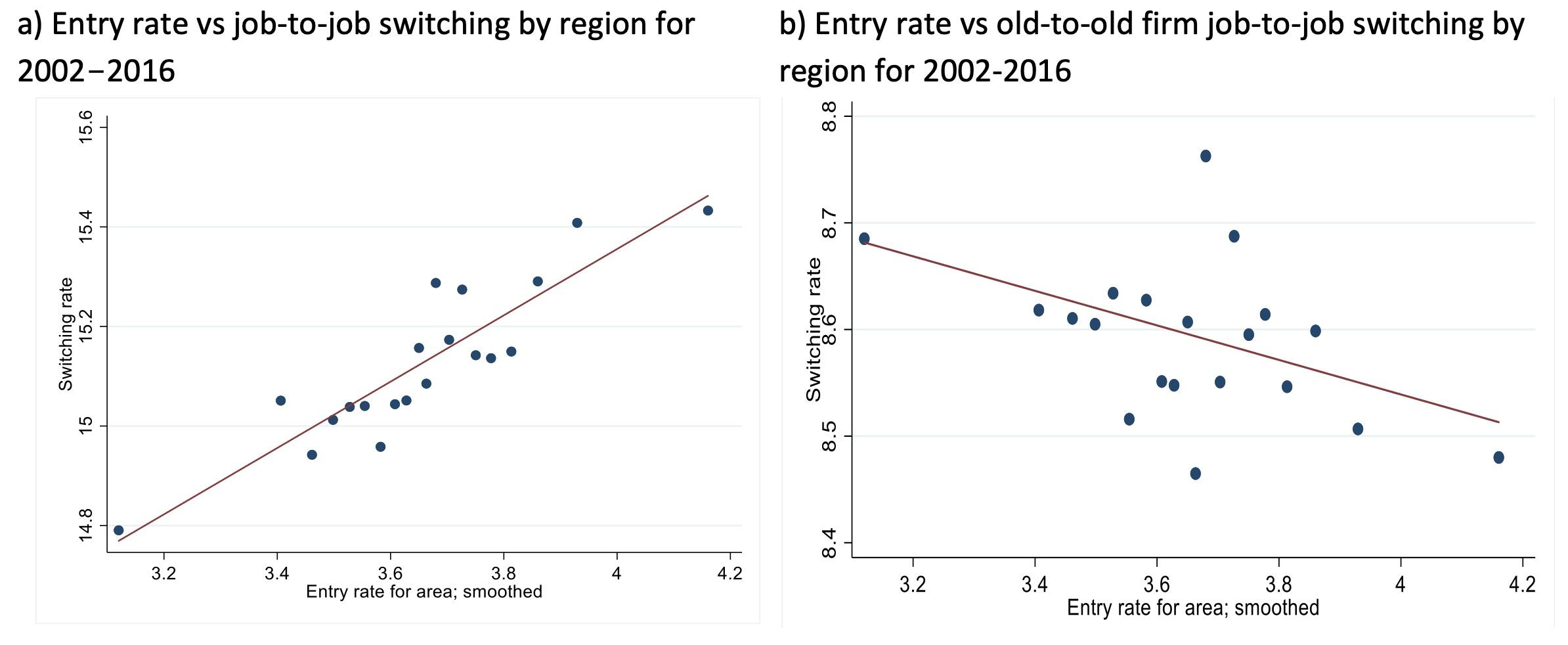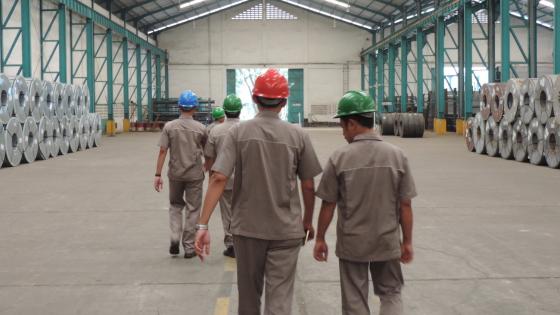Over recent years there has been a growing recognition of the role that concentrated labour markets can play in raising firms’ monopsony power and lowering workers’ wages (e.g. Azar et al. 2020, Benmelech et al. 2022, Dube et al. 2018, Abel et al. 2018). The intuition for why wages are lower in more concentrated markets is simple: when labour markets are concentrated, there will be fewer employers for employees to leverage when negotiating wage outcomes. The lack of outside options reduces workers’ bargaining power, and so can weigh on wages (e.g. Moscarini and Postel-Vinay 2017, Jarosch et al. 2019).
To date, most of the literature on this topic has focused on a fairly static view of monopsony power. All firms with a given market share are treated similarly, and the threat of firm entry is ignored. This is despite the fact that young firms tend to play a disproportionately large role in driving job-to-job switching as they grow post entry (e.g. Haltiwanger et al. 2018, Bilal et al. 2022). In contrast, in a recent paper I explore the roles that firm entry and dynamism play in decreasing monopsony power for incumbent firms (Humbur 2023).
Firm entry, job switching, and outside options
The important role that firm entry and dynamism plays in labour market dynamism has been documented in a number of papers. For example, Haltiwanger et al. (2018) show that young firms tend to poach workers from other firms as they grow. Similarly, Bilal et al. (2022) build a model with firm entry and frictional labour markets and show that a shock that lowers firm entry leads to a decline in poaching and job-to-job mobility. And Cali and Presidente (2023) show that regulations that prevent firm entry tend to lead to larger wage markdowns.
The important role that firm entry plays in creating outside options for workers is also evident in the Australian data. As in many countries, the rate of job-to-job switching has declined significantly in Australia over the past two decades (Deutscher 2019). Much of the decline in the overall rate of job-to-job switching has reflected a decline in the rate at which workers move from mature firms to young entrants, whereas the rate of job switching between mature firms has been fairly stable. These developments have occurred alongside a fall in the rate of firm entry, suggesting that declining rates of firm entry may have contributed to lower job-switching rates.
Figure 1 Firm entry rates and rate of job switching by firm age
Note: Young firms are 0 5 years, mature firms are older than 5 years. Job-to-job switching rates based on annual payment statement data.
The coincidence of declining job switching and firm entry is also evident at a local level. Figure 2a plots firm entry and job-to-job switching rates for each area and year, after removing are and time fixed effects. It shows that there is a strong positive correlation between firm entry rates and the rate of job to job switching, with job-switching rates increasing as firm entry rates in a region increase.
One potential explanation for this positive correlation is that both firm entry and job switching are driven by local economic conditions. For example, strong economic conditions could simultaneously encourage firm entry and provide workers with greater opportunities to move up the job ladder (e.g. Haltiwanger et al. 2018). However, the positive relationship between firm entry and job switching is only evident when focusing on switching between mature and young firms; there is no positive relationship between firm entry and the rate at which workers move between mature incumbent firms (Figure 2b). This suggest that the relationship between job-switching and entry does not simply reflect variation in local economic conditions, but captures the important role that entrants play in creating new outside options for workers.
Figure 2
Note: Figures plot entry rates for Statistical Area 4 or greater capital city areas versus the job to job switching rate. This is shown having residualised with respect to time fixed effects, area fixed effects, and the employment share of young firms. Approximately 780 region*year combinations based on 120 million workers. Old firms are firms more than 5 years old.
Source: Author’s calculations
Entry, monopsony, and concentration
Given the important role that firm entry seems to play in creating outside options for workers, it might be the case that concentration amongst incumbents has a smaller (absolute) effect on wages where firm entry and churn (i.e. entry plus exit) is higher. This is because workers may be able to leverage these additional outside options in wage bargaining.
To test this, I use linked administrative data on the universe of firms and workers in Australia to measure local labour market concentration at an industry-by-region level for the period from 2005-2016. I run simple, local labour market regressions of wages on concentration, controlling for various factors such as average productivity in the market, local and industry level cycles, and market fixed effects.
Consistent with the existing literature, I find a strong negative relationship between the degree of concentration in a local labour market and wages in that market, after accounting for the level of productivity (i.e. there are larger wage markdowns in more-concentrated local labour markets). This is also evident at a firm level, with a firm’s wage tending to be lower if the firm has a higher share of the employment in the local market, after accounting for firm-level productivity and the overall degree of labour market concentration. This finding is consistent with models of oligopsony.
While the average degree of concentration across labour markets has not changed in Australia over time, the estimated effect of concentration on wages has increased. Specifically, the estimated coefficient on concentration has more than doubled between the mid-2000s and the mid-2010s.
The increase in the estimated effect of concentration mirrors findings in Benmelech et al. (2022) and naturally raises the question: what has been driving the changing relationship between concentration and wages? Given the discussion above, an obvious candidate is the decline in firm entry rates. I therefore explore how firm entry rates interact with labour market concentration in driving.
When I allow the coefficient on concentration to vary based on the rate of entry or churn in the industry (measured at the national level), lower rates of entry and churn are associated with a significantly larger (absolute) effect of concentration on wages. To put the changes in context, firm entry rates in Australia declined by around 5 percentage points over the sample. Based on the estimated coefficients, all else equal this change would have increased the effect of concentration by around one half. Declining firm entry can therefore potentially account for some of the surprising weakness in wages growth over the 2010s (e.g. Cassidy 2019), as it appears to have contributed to weaker worker bargaining power.
Using the same data, I also explore the role of declining union membership and occupational mobility, which Benmelech et al. (2022) and Schubert et al. (2021), respectively, argue could increase the effect of measured employer concentration. I find some evidence that declining union membership is associated with larger effects of concentration on wages, similar to the findings in Benmelech et al. (2022) for the US and, to a lesser extent, those of Abel et al. (2018) for the UK. However, the results suggest that declining firm entry rates have been a more important driver of increasing monopsony power in Australia over this period.
Conclusions and policy implications
Previous work has documented the fact that declining firm entry and dynamism can lower wages growth indirectly by weighing on productivity growth (e.g. Decker et al. 2020). My results point to a second, more-direct channel: declining firm entry and dynamism weighs on worker bargaining power by limiting the number of outside options they can leverage in negotiations. Put another way, firm entry plays an important role in creating competition for workers for incumbent firms. This highlights the need for more work linking firm and labour market dynamism, in the vein of Bilal et al. (2022).
From a policy perspective this work highlights the importance of understanding and addressing the causes of declining firm dynamism to address low wages growth. It also highlights the important role that firm entry plays in generating competition, including in labour markets, which needs to be considered in competition policy.
References
Abel, W, S Tenreyro, and G Thwaites (2018), "Monopsony in the UK”, CEPR Discussion Paper 13265 (see also the Vox column here).
Azar J, I Marinescu, M Steinbaum and B Taska (2020), “Concentration in US Labor Markets: Evidence From Online Vacancy Data”, Labour Economics, 66 101886 (see also the Vox column here).
Benmelech E, N K Bergman and H Kim (2022), "Strong Employers and Weak Employees: How Does Employer Concentration Affect Wages?", The Journal of Human Resources 57(S): S200–S250.
Bilal AG, N Engbom, S Mongey and GL Violante (2022), “Firm and Worker Dynamics in a Frictional Labor Market”, Econometrica 90(4): 1425-1462.
Calì, M and G Presidente (2023), “Product Market Monopolies and Labor Market Monopsonies”, World Bank Policy Research Working Paper No. 10388 (see also the Vox column here).
Cassidy N (2019), “Low Wage Growth in Australia – An Overview”, paper presented at the annual RBA conference on “Low Wage Growth”, Sydney, 4–5 April.
Decker R A, J Haltiwanger, R S Jarmin and J Miranda (2020), "Changing Business Dynamism and Productivity: Shocks versus Responsiveness", The American Economic Review 110(12): 3952–3990
Deutscher N (2019), "Job-to-Job Transitions and the Wages of Australian Workers", Treasury Working Paper No 2019-07.
Dube, A, J Jacobs, S Naidu, and S Suri (2018), “Monopsony in Online Labor Markets”, NBER Working Paper 24416 (see also the Vox column here).
Haltiwanger J C, H R Hyatt, L B Kahn and E McEntarfer (2018), “Cyclical Job Ladders by Firm Size and Firm Wage”, American Economic Journal: Macroeconomics 10(2): 52-85.
Hambur, J (2023), “Did Labour Market Concentration Lower Wages Growth Pre-COVID?”, Research Discussion Paper 2023-02, Reserve Bank of Australia.
Jarosch G, J S Nimczik and I Sorkin (2019), “Granular Search, Market Structure, and Wages”, NBER Working Paper No 26239 (revised May 2020).
Moscarini G and F Postel-Vinay (2017), “The Relative Power of Employment-to-Employment Reallocation and Unemployment Exits in Predicting Wage Growth”, The American Economic Review 107(5): 364–368.
Schubert G, A Stansbury and B Taska (2021), “Employer Concentration and Outside Options”, Washington Center for Equitable Growth Working Paper (revised March 2022).





